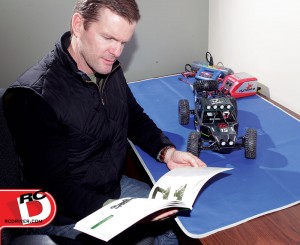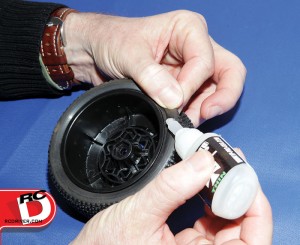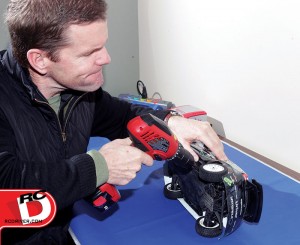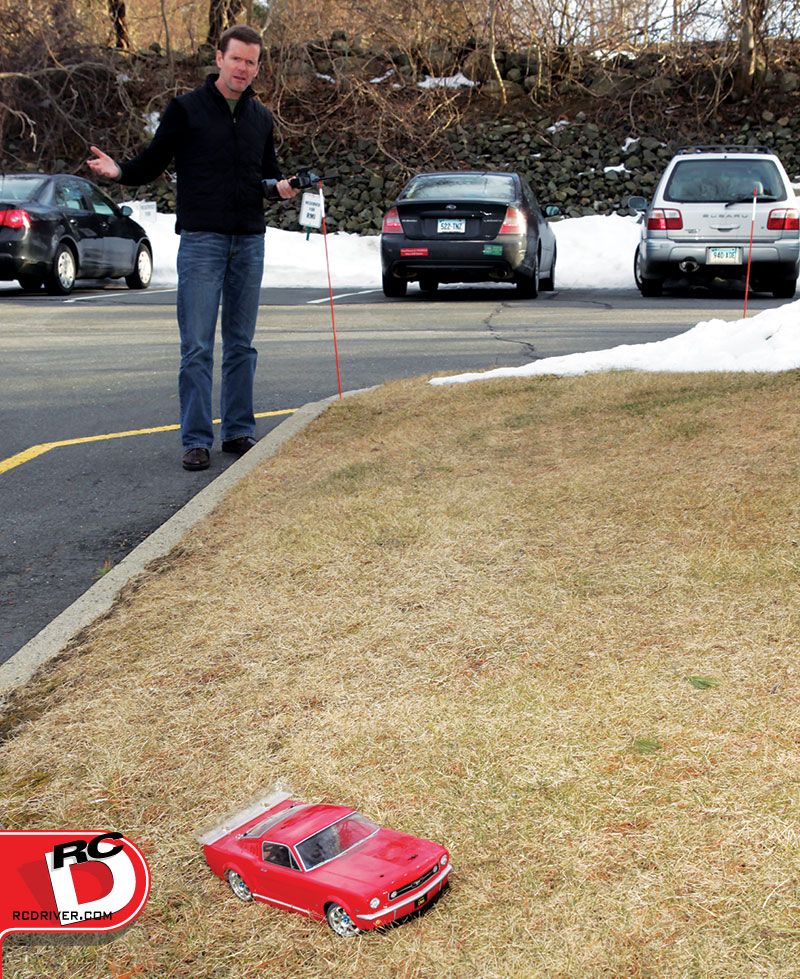1. Buy the right vehicle- Just saying, “I want an RC car,” isn’t good enough. You really have to think about what type of vehicle you want. Where do you want to run; on-road or off-road? Do you want nitro or electric? Does the space where you will be running your car dictate the scale of vehicle you need? Do you want a kit, a ready-to-run, a roller that’s built but you can add your own electronics? These are all questions you need to know the answers to when walking into a shop to buy your car. You don’t want to walk home with a cool-looking, ultra-scale touring car and set the thing down in the dirt in your backyard only to find out it won’t go anywhere. Similarly, you probably won’t have a lot of fun picking up a high riding, powerful monster truck to try slaloming cones in a parking lot. You’ll find yourself doing lots of hiking to flip over a truck that spends a lot of time on its lid. With a nitro car, will you be able to tune the engine? With an electric car, will you get the power you are looking for? Take the time to research the right car for you. It’s great to make friends with your hobby shop salesman so he can help lead you in the right direction for your needs.
2. Read the instructions- Those papers that come with your new vehicle purchase are not for scaling  your catch after a fishing trip. Nor are they for lining your bird cage or making paper airplanes with really sharp tips to throw with maximum velocity at your friends, Tony Phalen. Take out any and all paperwork included in your kit and go through everything. Read the instructions from start to finish even though you may be familiar with some steps. You never know when you’ll find a tip or tweak you weren’t aware of. The instructions will give you tips on how to turn on your ride or charge the batteries and perhaps how to trim the transmitter and they will also make you aware of all of the components. Instructions will give you tips on maintenance, tuning and set-ups. The instructions will even give you an idea of teardown and repairs and part numbers for when you need to order spare or replacement parts. Instructions and manuals should always be kept for the life of your vehicle; you never know when you’ll need them for reference.
your catch after a fishing trip. Nor are they for lining your bird cage or making paper airplanes with really sharp tips to throw with maximum velocity at your friends, Tony Phalen. Take out any and all paperwork included in your kit and go through everything. Read the instructions from start to finish even though you may be familiar with some steps. You never know when you’ll find a tip or tweak you weren’t aware of. The instructions will give you tips on how to turn on your ride or charge the batteries and perhaps how to trim the transmitter and they will also make you aware of all of the components. Instructions will give you tips on maintenance, tuning and set-ups. The instructions will even give you an idea of teardown and repairs and part numbers for when you need to order spare or replacement parts. Instructions and manuals should always be kept for the life of your vehicle; you never know when you’ll need them for reference.
3. Charge your batteries- Everyone is excited when they get their first vehicle. Some are so excited they don’t fully charge their batteries. This causes reduced runtime, glitching and even reduced range. Remember, receiver packs and glow igniters for nitro vehicles need to be charged, too! Battery packs have a memory in them and if you don’t train them right from the start, they will have a worse memory than Greg. Just ask him what he ate for breakfast the previous day, I bet he won’t know. Read the instructions that came with the battery (that sounds familiar) and charge it, discharge it and store it as per the manufacturer’s recommendations. They gave you those recommendations because they are the experts on their product and they want you to have a good experience with it. Also make sure you purchase the proper charging equipment. Many chargers are universal nowadays, but you should still make sure the charger you get is compatible with the chemistry of your battery.
4. Glue your tires- With the speeds that most cars reach, or that a newbie thinks they reach, you can  assume that those soft rubber tires on your car need to stay on the rims somehow. However, if you want to make a spectacle of yourself at the track or basher field, go right ahead and blow some tires off your rims as soon as you hit the throttle. They will be fun to run after… trust us. But seriously, take the proper steps to clean your tires and rims with a cleaning agent like Simple Green or electric motor spray to remove any oils from the surfaces. Then use a quality glue to adhere the bead of the tire to the rim. Give the glue time to dry, too. You don’t want to perform a quick glue job, bolt up your tires, grab the throttle and have glue fly off in your face while the tire is being flung off the rim (we’ve seen it happen.) Take the time, glue all of your tires properly and make sure you use the right CA glue. Greg once grabbed a bottle of de-bonder to glue his tires and they all fell off his 4WD car the instant he hit the front straight…. We just can’t make these things up!
assume that those soft rubber tires on your car need to stay on the rims somehow. However, if you want to make a spectacle of yourself at the track or basher field, go right ahead and blow some tires off your rims as soon as you hit the throttle. They will be fun to run after… trust us. But seriously, take the proper steps to clean your tires and rims with a cleaning agent like Simple Green or electric motor spray to remove any oils from the surfaces. Then use a quality glue to adhere the bead of the tire to the rim. Give the glue time to dry, too. You don’t want to perform a quick glue job, bolt up your tires, grab the throttle and have glue fly off in your face while the tire is being flung off the rim (we’ve seen it happen.) Take the time, glue all of your tires properly and make sure you use the right CA glue. Greg once grabbed a bottle of de-bonder to glue his tires and they all fell off his 4WD car the instant he hit the front straight…. We just can’t make these things up!
5. Don’t over oil- Your RC car is not a Ford F-350. You do not need to fill the transmission with oil. You do not need to pack your axles full of grease. Wheel and axle bearings should never be dripping with oil like icing from a cinnamon bun. Youngsters often get carried away and try to apply way too much oil to bearings and bushings and anything that moves. Sure, a well lubricated machine works well, but too much oil just attracts dirt and debris and will actually cause parts to wear more quickly. Additionally, many of the newer bearings in vehicles today are rubber sealed. What does this mean for you? It means you probably won’t need to apply oil all that much, if ever.
6. Never, ever, place your vehicle down on the straightaway – New racers lack some basic track knowledge and etiquette. One important example of this is knowing where to place your car down on the track. When heading off to the track to practice or race, never, ever just set your vehicle down on the straightaway and walk up to the drivers’ stand. Too often, when someone does this, a vehicle heading down the straight at full speed won’t see the vehicle parked there and will plow right in to it. When this happens a very loud bang occurs as the vehicles collide nose to tail and one or both of the vehicles is usually broken. Always find a quiet corner where there is not too much action and place your vehicle down there. If you are not sure where a good spot is, watch where other racers are placing their cars down.
Get more useful tips and how to’s from RC Driver, subscribe to our Youtube channel HERE
7. Remember the glow igniter – Chris received a phone call from an irate customer the other day that went a little something like this. Customer: “I’ve been yanking on this pull start for over an hour and this engine will not fire up! What is up with this piece of junk you sold me?” Chris: “Is the glow igniter on the engine?” Customer: “What is that?” Chris: “The piece that attaches to the top of the engine to heat the glow plug; there is one in the box.” At that point there was a long silence and the customer just hung up. Remember, nitro engines do not have a spark plug like your real car engine. They need the external glow igniter to heat the glow plug (similar to a spark plug) to get the engine to fire up. Also, always remember to charge the glow plug or to change the battery your plug uses an alkaline battery that has been used multiple times.
8. Break in your nitro engine – So, you remembered the glow igniter, now what? Excited newbies often fuel up their nitro vehicles without taking the time to break in their engines before reaching for full throttle. Once they hear the engine purr, their good intentions of breaking the engine in are overrun by emotions and in less than a minute they are tearing that shiny new vehicle up and down the street at full throttle. This is a very bad idea! Always break in nitro engines to the manufacturer’s specs, which are usually listed in the instruction manual. This will result in better performance and longer life expectancy for the engine. Additionally, the instruction manual will have tuning tips that help ensure top performance over time.
9. Tighten, but don’t over tighten – Remember, just because you may have 24-inch python type arms  like Hulk Hogan does not mean you have to torque everything down to the point of no return. When building a kit be sure not to over tighten screws as this can often cause the plastic to stress and strip out. When this happens be prepared to do the walk of shame back to your local hobby shop and purchase replacement parts. Also, when tightening on wheels, people will often twist the nuts on so hard that the wheel will barely spin. This is not a good idea as it causes a great deal of stress on the drivetrain and motor.
like Hulk Hogan does not mean you have to torque everything down to the point of no return. When building a kit be sure not to over tighten screws as this can often cause the plastic to stress and strip out. When this happens be prepared to do the walk of shame back to your local hobby shop and purchase replacement parts. Also, when tightening on wheels, people will often twist the nuts on so hard that the wheel will barely spin. This is not a good idea as it causes a great deal of stress on the drivetrain and motor.
10. Set the LiPo cut-off- Most ready-to-run vehicles today come with NiMH battery packs and the speed controls on these vehicles are programmed as such. So, when upgrading to a faster, more powerful and lighter LiPo pack, change the settings on the speed control to reflect this. Failure to do so will cause your new, often expensive, LiPo battery to run down too low. When this happens the pack will not take a change and will only be good as an expensive paperweight to remind you to set the LiPo cut-off in the future.
11. An extra for good measure. Buy from your local hobby shop – So, you found a cheap vehicle at www.cheap-rc-cars.com.org.net.co.biz. Who is going to help you out when you have a problem? While you might pay a bit more at a brick and mortar store, the customer service you will receive can save many hours in frustration. In addition, when you do need help, labor is often reduced if you bought the vehicle at your local hobby shop. This is not the case when bought online.
WRAP-UP
We all were beginners at some point and I sure do wish I knew all of this when I first hit the track back in 1997. While this won’t solve all the problems or answer all the questions a newbie may have, I am sure it will get them started on the right foot for a long, enjoyable time at the track racing or at home bashing.
 RC Driver The Best In RC Car & Truck News, Reviews & Video
RC Driver The Best In RC Car & Truck News, Reviews & Video 









Hi Guys,
Great article and tips!
I’ve been working in hobby shops for over 15years now,
And still see nearly all these problems everyday!!
I’ve posted these tips on my page for everyone to read…
As so many people are overwhelmed by the industrie and what to buy,
I run my shop by myself and the more people who see this the better.
Thanks again and regards
Ed McKinley
Complete R/C
Canberra
Australia
These are really good pointers to know. To add for number 1 advise, when buying the right vehicle, a person should also know what the feedback is the product getting. If a certain product and brand has positive or negative reviews, and they must also be legitimate. It’s very important so it would be worth the money.
Shoulda added: as soon as you notice something is wrong with the vehicle (weird noises, won’t run straight etc. …) find out what it is RIGHT AWAY.
That advice could have saved my 1/8th scale motor and controller a couple of weeks ago